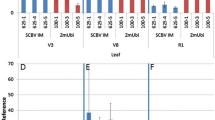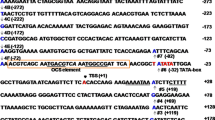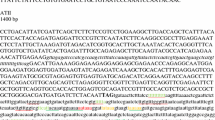Abstract
Transcriptional enhancers possess the ability to override the tissue-specificity and efficiency of nearby promoters, which is of concern when generating transgenic constructs bearing multiple cassettes. One means of preventing these inappropriate interactions is through the use of enhancer-blocking insulators. The 2-kb transformation booster sequence (TBS) from Petunia hybrida has been shown previously to exhibit this function when inserted between an enhancer and promoter in transgenic Arabidopsis thaliana. In this study, we attempted to further characterize the ability of this fragment to impede enhancer–promoter interference through an analysis of transgenic Arabidopsis and Nicotiana tabacum lines bearing various permutations of the TBS element between the cauliflower mosaic virus (CaMV) 35S enhancer and an assortment of tissue-specific promoters fused to the β-glucuronidase (GUS) reporter gene. The full-length TBS fragment was found to function in both orientations, although to a significantly lesser degree in the reverse orientation, and was operational in both plant species tested. While multiple deletion fragments were found to exhibit activity, it appeared that several regions of the TBS were required for maximal enhancer-blocking function. Furthermore, we found that this element exhibited promoter-like activity, which has implications in terms of possible mechanisms behind its ability to impede enhancer–promoter communication in plants.





Similar content being viewed by others
References
Abhyankar MM, Urekar C, Reddi PP (2007) A novel CpG-free vertebrate insulator silences the testis-specific SP-10 gene in somatic tissues. J Biol Chem 282:36143–36154
Alonso JM, Stepanova AN, Leisse TJ, Kim CJ et al (2003) Genome-wide insertional mutagenesis of Arabidopsis thaliana. Science 301:653–657
Antes TJ, Namciu SJ, Fournier REK, Levy-Wilson B (2001) The 5′ boundary of the human apolipoprotein B chromatin domain in intestinal cells. Biochemistry 40:6731–6742
Bae E, Calhoun VC, Levine M, Lewis EB, Drewell RA (2002) Characterization of the intergenic RNA profile at abdominal-A and Abdominal-B in the Drosophila bithorax complex. Proc Natl Acad Sci 99:16847–16852
Banerji J, Rusconi S, Schaffner W (1981) Expression of a beta-globin gene is enhanced by remote SV40 DNA sequences. Cell 2:299–308
Barges S, Mihaly J, Galloni M, Hagstrom K, Müller M, Shanower G, Schedl P, Gyurkovics H, Karch F (2000) The Fab-8 boundary defines the distal limit of the bithorax complex iab-7 domain and insulates iab-7 from initiation elements and a PRE in the adjacent iab-8 domain. Development 127:779–790
Bell AC, Felsenfeld G (2000) Methylation of a CTCF-dependent boundary controls imprinted expression of the Igf2 gene. Nature 405:482–485
Bi X, Broach JR (2006) UASrpg can function as a heterochromatin boundary element in yeast. Genes Dev 13:1089–1101
Butler JE, Kadonaga JT (2001) Enhancer–promoter specificity mediated by DPE or TATA core promoter motifs. Gene Dev 15:2515–2519
Cande JD, Chopra VS, Levine M (2009) Evolving enhancer–promoter interactions within the tinman complex of the flour beetle, Tribolium castaneum. Development 136:3153–3160
Charrier B, Champion A, Kreis M (2002) Expression profiling of the whole Arabidopsis Shaggy-like kinase multigene family by real-time reverse transcriptase-polymerase chain reaction. Plant Physiol 130:1–14
Chopra VS, Cande J, Hong JW, Levine M (2009) Stalled Hox promoters as chromosomal boundaries. Genes Dev 23:1505–1509
Chung JH, Whiteley M, Felsenfeld G (1993) A 5′ element of the chicken β-globin domain serves as an insulator in human erythroid cells and protects against position effect in Drosophila. Cell 74:505–514
Clough SJ, Bent AF (1998) Floral dip: a simplified method for Agrobacterium-mediated transformation of Arabidopsis thaliana. Plant J 16:735–743
Dobi KC, Winston F (2007) Analysis of transcriptional activation at a distance in Saccharomyces cerevisiae. Mol Cell Biol 27:5575–5586
Drewell RA, Bae E, Burr J, Lewis EB (2002) Transcription defines the embryonic domains of cis-regulatory activity at the Drosophila bithorax complex. Proc Natl Acad Sci USA 99:16853–16858
Gaszner M, Felsenfeld G (2006) Insulators: exploiting transcriptional and epigenetic mechanisms. Nat Rev Genet 7:703–713
Geyer PK (1997) The role of insulator elements in defining domains of gene expression. Curr Opin Genet Dev 7:242–248
Geyer PK, Spana C, Corces VG (1986) On the molecular mechanism of gypsy-induced mutations at the yellow locus of Drosophila melanogaster. EMBO J 5:2657–2662
Goderis IJWM, De Bolle MFC, François IEJA, Wouters PFJ, Broekaert WF, Cammue BPA (2002) A set of modular plant transformation vectors allowing flexible insertion of up to six expression units. Plant Mol Biol 50:17–27
Gudynaite-Savitch L, Johnson DA, Miki BLA (2009) Strategies to mitigate transgene–promoter interactions. Plant Biotechnol J 7:472–485
Hagstrom K, Muller M, Schedl P (1996) Fab-7 functions as a chromatin domain boundary to ensure proper segment specification by the Drosophila bithorax complex. Genes Dev 10:3202–3215
Hajdukiewicz P, Svab Z, Maliga P (1994) The small, versatile pPZP family of Agrobacterium binary vectors for plant transformation. Plant Mol Biol 25:989–994
Hark AT, Schoenherr CJ, Katz DJ, Ingram RS, Levorse JM, Tilghman SM (2000) CTCT mediates methylation-sensitive enhancer-blocking activity at the H19/Igf2 locus. Nature 405:486–489
Hily JM, Liu Z (2009) A simple and sensitive high-throughput GFP screening in woody and herbaceous plants. Plant Cell Rep 28:493–501
Hily JM, Singer SD, Yang Y, Liu Z (2009) A transformation booster sequence (TBS) from Petunia hybrida functions as an enhancer-blocking insulator in Arabidopsis thaliana. Plant Cell Rep 28:1095–1104
Honma T, Goto K (2000) The Arabidopsis floral homeotic gene PISTILLATA is regulated by discrete cis-elements responsive to induction and maintenance signals. Development 127:2021–2030
Horsch RB, Fry JE, Hoffmann NL, Wallroth M, Eichholtz D, Rogers SG, Fraley RT (1985) A simple and general method for transferring genes into plants. Science 227:1229–1231
Jagannath A, Bandyopadhyay P, Arumugam N, Gupta V, Kumar P, Pental D (2001) The use of a Spacer DNA fragment insulates the tissue-specific expression of a cytotoxic gene (barnase) and allow high-frequency generation of transgenic male sterile lines in Brassica juncea L. Mol Breeding 8:11–23
Jefferson RA, Kavanagh TA, Bevan MW (1987) GUS fusions: β-glucuronidase as a sensitive and versatile gene fusion marker in higher plants. EMBO J 6:3901–3907
Juven-Gershon T, Hsu JY, Kadonaga JT (2008) Caudal, a key developmental regulator, is a DPE-specific transcriptional factor. Genes Dev 22:2823–2830
Kadauke S, Blobel GA (2009) Chromatin loops in gene regulation. Biochim Biophys Acta 1789:17–25
Kay R, Chan A, Daly M, McPherson J (1987) Duplication of CaMV 35S promoter sequences creates a strong enhancer for plant genes. Science 236:1299–1302
Kellum R, Schedl P (1992) A group of scs elements function as domain boundaries in an enhancer-blocking assay. Mol Cell Biol 12:2424–2431
Kim A, Zhao H, Ifrim I, Dean A (2007) β-globin intergenic transcription and histone acetylation dependent on an enhancer. Mol Cell Biol 27:2980–2986
Ling J, Baibakov B, Pi W, Emerson BM, Tuan D (2005) The HS2 enhancer of the β-globin locus control region initiates synthesis of non-coding, polyadenylated RNAs independent of a cis-linked globin promoter. J Mol Biol 350:883–896
Murashige T, Skoog F (1962) A revised medium for rapid growth and bioassays with tobacco tissue cultures. Physiol Plantarum 15:473–497
Namciu SJ, Blochlinger KB, Fournier REK (1998) Human matrix attachment regions insulate transgene expression from chromosomal position effects in Drosophila melanogaster. Mol Cell Biol 18:2382–2391
Odell JT, Knowlton S, Lin W, Mauvais J (1988) Properties of an isolated transcription stimulating sequence derived from the cauliflower mosaic virus 35S promoter. Plant Mol Biol 10:263–272
Ohta S, Mita S, Hattori T, Nakamura K (1990) Construction and expression in tobacco of a β-glucuronidase (GUS) reporter gene containing an intron within the coding sequence. Plant Cell Physiol 31:805–813
Raab JR, Kamakaka RT (2010) Insulators and promoters: closer than we think. Nat Rev Genet 11:439–446
Reese MG (2001) Application of a time-delay neural network to promoter annotation in the Drosophila melanogaster genome. Comput Chem 26:51–56
Rosso MG, Li Y, Strizhov N, Reiss B, Dekker K, Weisshaar B (2003) An Arabidopsis thaliana T-DNA mutagenized population (GABI-Kat) for flanking sequence tag-based reverse genetics. Plant Mol Biol 53:247–259
Routledge SJE, Proudfoot NJ (2002) Definition of transcriptional promoters in the human β globin locus control region. J Mol Biol 323:601–611
Sadeghi A, Broeders S, De Greve H, Hernalsteens J-P, Peumans WJ, Van Damme EJM, Smagghe G (2007) Expression of garlic leaf lectin under the control of the phloem-specific promoter Asus1 from Arabidopsis thaliana protects tobacco plants against the tobacco aphid (Myzus nicotianae). Pest Manag Sci 63:1215–1223
Scott KC, Taubman AD, Geyer PK (1999) Enhancer blocking by the Drosophila gypsy insulator depends upon insulator anatomy and enhancer strength. Genetics 153:787–798
Singer SD, Cox KD, Liu Z (2010a) Both the constitutive Cauliflower Mosaic Virus 35S and tissue-specific AGAMOUS enhancers activate transcription autonomously in Arabidopsis thaliana. Plant Mol Biol 74:293–305
Singer SD, Hily J-M, Liu Z (2010b) A 1 kb bacteriophage lambda fragment functions as an insulator to effectively block enhancer–promoter interactions in Arabidopsis thaliana. Plant Mol Biol Rep 28:69–76
Singer SD, Cox KD, Liu Z (2011) Enhancer–promoter interference and its prevention in transgenic plants. Plant Cell Rep 30:723–731
Spana C, Harrison DA, Corces VA (1988) The Drosophila melanogaster suppressor of Hairy-wing protein binds to specific sequences of the gypsy retrotransposon. Genes Dev 2:1414–1423
Steinwaerder DS, Lieber A (2000) Insulation from viral transcriptional regulatory elements improves inducible transgene expression from adenovirus vectors in vitro and in vivo. Gene Ther 7:556–567
Tchurikov NA, Kretova OV, Moiseeva ED, Sosin DV (2009) Evidence for RNA synthesis in the intergenic region between enhancer and promoter and its inhibition by insulators in Drosophila melanogaster. Nucleic Acids Res 37:111–122
Tuan D, Kong S, Hu K (1992) Transcription of the hypersensitive site HS2 enhancer in erythroid cells. Proc Natl Acad Sci USA 89:11219–11223
van der Geest AHM, Hall TC (1997) The β-phaseolin 5′ matrix attachment region acts as an enhancer facilitator. Plant Mol Biol 33:553–557
van Engelen FA, Molthoff JW, Conner AJ, Nap J-P, Pereira A, Stiekema WJ (1995) pBINPLUS: an improved plant transformation vector based on pBIN19. Transgenic Res 4:288–290
Wallace JA, Felsenfeld G (2007) We gather together: insulators and genome organization. Curr Opin Genet Dev 17:400–407
West AG, Gaszner M, Felsenfeld G (2002) Insulators: many functions, many mechanisms. Genes Dev 16:271–288
Yang Y, Singer SD, Liu Z (2011) Evaluation and comparison of the insulation efficiency of three enhancer-blocking insulators in plants. Plant Cell Tiss Org 105:405–414
Ye X, Liang M, Meng X, Ren X, Chen H, Li ZY, Ni S, Lieber A, Hu F (2003) Insulation from viral transcriptional regulatory elements enables improvement to hepatoma-specific gene expression from adenovirus vectors. Biochem Biophys Res Commun 307:759–764
Zheng X, Deng W, Luo K, Duan H, Chen Y, McAvoy R, Song S, Pei Y, Li Y (2007) The cauliflower mosaic virus (CaMV) 35S promoter sequence alters the level and patterns of activity of adjacent tissue- and organ-specific gene promoters. Plant Cell Rep 26:1195–1203
Zhong X-P, Krangel MS (1997) An enhancer-blocking element between α and δ gene segments within the human T cell receptor α/δ locus. Proc Natl Acad Sci 94:5219–5224
Acknowledgments
The authors wish to thank Sara Villani for her invaluable technical assistance and Dr. Zongrang Liu (ARS-USDA, Kearneysville, WV) for his generosity in supplying a sample of the TBS element. This study was supported by state, federal, and institutional funds appropriated to the New York State Agricultural Experiment Station, Cornell University.
Author information
Authors and Affiliations
Corresponding author
Additional information
Communicated by R. Schmidt.
Rights and permissions
About this article
Cite this article
Singer, S.D., Hily, JM. & Cox, K.D. Analysis of the enhancer-blocking function of the TBS element from Petunia hybrida in transgenic Arabidopsis thaliana and Nicotiana tabacum . Plant Cell Rep 30, 2013–2025 (2011). https://doi.org/10.1007/s00299-011-1109-8
Received:
Revised:
Accepted:
Published:
Issue Date:
DOI: https://doi.org/10.1007/s00299-011-1109-8




